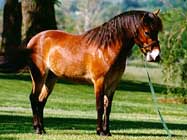Gotland Pony
N/A
Fri, 18th April, 2025 - 8:59 pm GMT
Sponsor Ads:

Alternative Name
N/ABasic Info
The Gotland is light and elegant in conformation. The breed has pronounced withers, a long back, and a sloping croup. The chest is deep, and the shoulders long and sloping. The legs are strong and the feet are hard. Gotlands stand 11.2 to 13 hands (46-52") at the withers. Dun and bay predominate in the breed, but all colors are allowed except albinos, roans, and piebalds.
Health
N/AHabitat
N/ABehavior
Characteristic of the breed is a gentle disposition and a lively intelligence. Gotlands are athletic, making excellent trotters and jumpers. Though strong enough to carry adults, they are primarily used for driving and as children's mountsOrigin
GotlandHistory
History and Origin of the Breed The Gotland pony, or Russ, as it is called in Sweden, has lived in the forest region of the island of Gotland from time immemorial. Their history is mysterious and fascinating. Discoveries from the Stone Age show that horses have been present on Gotland for 4,000 – 5,000 years, and perhaps longer. It is not known whether these horses were Russ horses, nor is it know how the first horses came to the island. Could it have been wild horses that came over a land bridge some 10,000 years ago? Or was it tame horses brought by humans by boat 4,000 years ago, when horses first began to be used in Scandinavia? Russ, the Swedish word for the Gotland pony, comes from Old Norse hross and is related to English word "horse." Gotlanders themselves often call the ponies, skogsbaggar, which means "forest rams" or "little horse of the woods." It is commonly thought that the Russ, as other European horse breeds, is a descendant of the wild Tarpan. There are few ancient references to the Gotland ponies, but it generally believed that they lived in freedom in the forests in a half-wild state. Discoveries made in the Iron Age village called Vallhagar (220 B. C. – 500 A. D.), a few kilometres from Lojsta Moor, show that horses became increasingly common as domestic animals during that period. The oldest reference to the Russ is found is Skånelagen, a legal code from the 13th century, where "the wild horses of Gotland" are mentioned. In the beginning of the 19th century the ponies could be found throughout Gotland, especially in the large forests in the middle of the island. Farmers kept Russes on their farms as draft horses. They often had a herd of free-roving horses in the forest as well, so they would be able to bring in new young horses to farm when needed. There were no fences, and the horses had to forage for themselves. During cold winters with heavy snowfall, they often had a hard time finding food, so they would make their way to the haystacks around the farms. In the mid-19th century the situation changed; the number of Gotland ponies dropped sharply. Many were sold to England, Germany and Belgium where they were used for mining and other chores. On Gotland, formerly public lands were parceled out to individual farmers, which meant that more land was farmed and much of the forested area began to be cultivated. The expansive, contiguous forests were intersected by fences and cultivated land and could no longer function as foraging areas. In addition, the ponies caused great damage when they grazed and trampled down the sown fields, and they began to be seen as pests. In the beginning of the 20th century only about 150 Gotland ponies were left, but a few people with foresight had taken note of Sweden’s most primitive horse. The Russ began to be exhibited at the summer fairs held by the Gotland Agricultural Society, and a few stud farms were established to breed the horses. But the number of Russes continued to fall. The meat rationing and food shortages of World War I led poachers to hunt the Russ. The forest ponies of Gotland were near extinction. Then a few farmers in the communities of Gerum and Lojsta, together with the Gotland Agricultural Society intervened to save the Russ. They fenced in about 200 acres, the area that now constitutes the winter pasture. There five Russes that had been captured on the moor were let run, together with three other Russes that were donated by a stud farm that had gone out of business. In this area the horses were allowed to run free, and soon a little Russ tribe had developed. These horses formed the basis for the breeding that has been carried out at Lojsta Moor in an effort to maintain the stock as pure as possible.* Today, there are about 9,000 Russes in Sweden and they can also be found in Denmark, Finland and the United States. Gotlands were first imported into the United States in the 1950s for use in handicapped riding programs. A registry was formed in the 1960s, and over 500 animals have been registered in the past thirty years. The breed almost became extinct in North America during the 1980s. The American Livestock Breeds Conservancy and a small number of breeders have worked to encourage a revival of the Gotland breed. Over one hundred purebred Gotlands are currently found in the U.S. today, and the population is increasing.Common Foods
grassSponsor Ads:
Firestone's Law of Forecasting: Chicken Little only has to be right once.
Gotland Pony
Coded by: BGID® | ALL RIGHTS RESERVED Copyright © 2000-2025
Disclaimer | Privacy | Report Errors / Contact | Credits
















